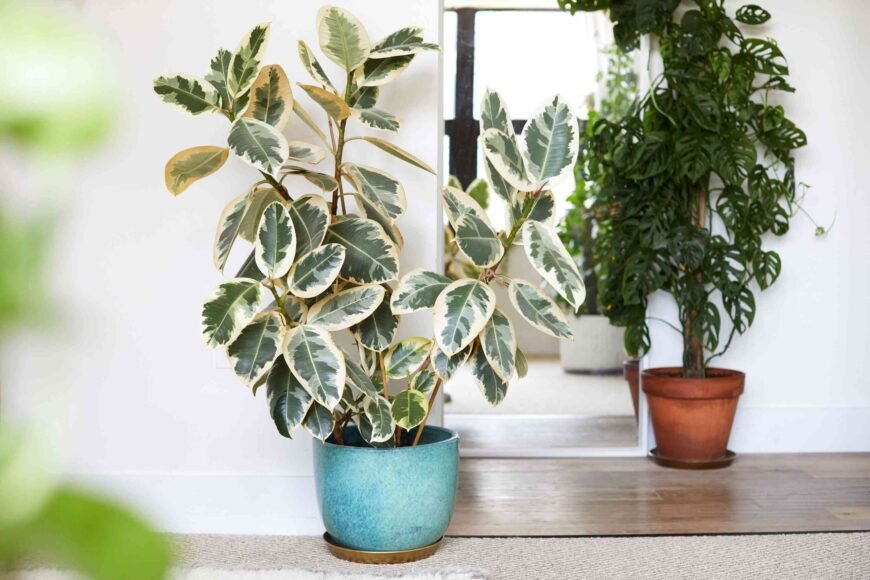| Common Name | Ficus Tineke, variegated rubber tree |
| Botanical Name | Ficus elastica ‘Tineke’ |
| Family | Moraceae |
| Plant Type | Perennial |
| Mature Size | 2–10 ft. tall, 1-2 ft. wide |
| Sun Exposure | Partial |
| Soil Type | Well-drained |
| Soil pH | Acidic, neutral |
| Hardiness Zones | 10-12 (USDA) |
| Native Area | Cultivar, no native range |
| Toxicity | Toxic to humans and pets |
Ficus Tineke Care
Warning
Ficus elastica is not native to North America and is potentially invasive. If you plant it outdoors, grow it in a container where its prolifically spreading roots are contained.
Light
Ficus elastica likes the type of bright, indirect light that mimics that found in its natural tropical forest habitat. Place the plant in an east-facing window or set it back from a south- or west-facing window. Avoid direct harsh afternoon sun.
Soil
Use loose and well-drained potting mix. Slightly acidic cactus mixes are a good option.
Water
Let the top couple of inches of potting mix dry out to the touch in between waterings. Deep watering once every one to two weeks during the growing season is usually enough, depending on the light and humidity in your home. Slightly underwatering is better than overwatering, as too much moisture leads to root rot.
Don’t drip water on the leaves as it may cause staining.
Temperature and Humidity
The ideal temperature range for ficus Tineke is between 60 and 75°F. It does not tolerate temperatures below 55°F well. Avoid sudden temperature drops and exposure to draughts, dry heat vents, and AC units.
Fertilizer
Feed the plant with a diluted liquid houseplant fertilizer every few weeks through the growing season in the spring and summer. Skip the fertilizer during the winter months.
Types
There are two other popular cultivars of Ficus elastica:
- Ficus elastica ‘Ruby’ has a unique tricolored variegation. It needs brighter light conditions to maintain the strong colors. With a height of 3 to 6 feet, it is smaller than the other cultivars.
- Ficus elastica ‘Burgundy’ has large, glossy, almost black leaves. In ideal conditions, it grows into a tall, upright tree of more than 12 feet in height.
Pruning
These fast-growing plants benefit from occasional tidying up to keep a neat shape, minimize leggy growth, and encourage the development of new, healthy foliage. Trim off straggly stems and unhealthy-looking leaves. Any healthy stems can be used to propagate a new plant.
Propagating Ficus Tineke
Propagating variegated rubber plants from stem cuttings is fairly easy. Do this in the spring as the new growing season starts.
- Take a 6-inch cutting with at least four leaf nodes from a healthy stem, using a clean, sharp blade.
- Remove the bottom leaves and only keep one leaf at the top.
- Dip the cut end in rooting hormone and insert the cutting in loose, well-drained soilless potting mix so the top node is exposed.
- To create a high-humidity environment, place an almost fully sealed plastic zip-top bag over the potted cutting. Don’t allow the bag to touch the cutting (a chopstick works well for this purpose).
- Place the potted cutting in a warm location with bright, indirect light and keep it evenly moist.
- Roots should begin to form in about a month. You’ll know if it’s been successful if there is resistance when you gently pull on the cutting.
Potting and Repotting Ficus Tineke
When the roots start to grow out of the drainage holes, it’s time to repot. These plants are relatively fast growers, so repotting every year or every to years is normal.
Pick a pot that’s only a few inches larger in diameter than the original one. Fill the pot with new, well-draining potting mix, leaving a couple of inches at the top of the pot free to allow watering.
Common Pests & Plant Diseases
Like other ficus, the plant is susceptible to mites, scale, mealybugs, whiteflies, and aphids. Control populations with insecticidal soap or neem oil before they turn into an infestation.
Ficus trees are also susceptible to leaf spot disease. Remove any infected leaves promptly to prevent the spread of the fungus.
Common Problems with Ficus Tineke
While these plants have relatively easy-going natures, here are issues to watch out for:
Leaves Turning Yellow
One of the first signs of overwatering is leaves turning yellow. Make sure to always check the soil before watering.
Yellow leaves can also be a sign your plant is exposed to strong draught.
Leaves Falling Off
Although some leaf loss is natural (as your plant grows, foliage lower on the plant will drop off), premature leaf drop is usually a sign of underwatering. Adjust your watering schedule and don’t let the potting mix dry out completely in between waterings.
Brown Tips
Leaves that turn crispy and develop brown tips may indicate too much direct sun. Move your plant to a position with dappled sunlight.
-
-
Variegated rubber plants are relatively fast growers. Expect them to grow up to 24 inches annually. They reach heights of up to 10 feet when grown indoors, but with the right conditions outside, they grow even faster and reach much taller heights.
-
-
-
Look after your plant well and it could live at least a couple of decades. These long-lived plants have been known to survive 100 years in ideal outdoor environments.
-
-
-
The biggest reason the pink hues disappear on these plants is because they aren’t getting enough light. Although they don’t thrive in spots with prolonged exposure to intense, direct sunlight, a position with access to bright, filtered light is important to retain the striking variegation.
-
